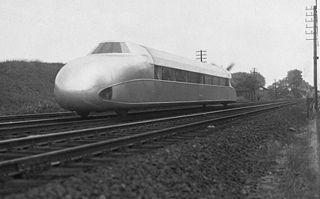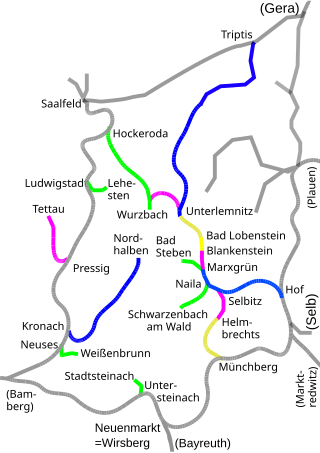
The Deutsche Reichsbahn, also known as the German National Railway, the German State Railway, German Reich Railway, and the German Imperial Railway, was the German national railway system created after the end of World War I from the regional railways of the individual states of the German Empire. The Deutsche Reichsbahn has been described as "the largest enterprise in the capitalist world in the years between 1920 and 1932"; nevertheless, its importance "arises primarily from the fact that the Reichsbahn was at the center of events in a period of great turmoil in German history".
The history of rail transport in Germany can be traced back to the 16th century. The earliest form of railways, wagonways, were developed in Germany in the 16th century. Modern German rail history officially began with the opening of the steam-powered Bavarian Ludwig Railway between Nuremberg and Fürth on 7 December 1835. This had been preceded by the opening of the horse-drawn Prince William Railway on 20 September 1831. The first long-distance railway was the Leipzig-Dresden railway, completed on 7 April 1839.

The Schienenzeppelin or rail zeppelin was an experimental railcar which resembled a Zeppelin airship in appearance. It was designed and developed by the German aircraft engineer Franz Kruckenberg in 1929. Propulsion was by means of a pusher propeller located at the rear: it accelerated the railcar to 230.2 km/h (143 mph) setting the land speed record for a petrol powered rail vehicle. Only a single example was ever built, which due to safety concerns remained out of service and was finally dismantled in 1939.

The Anhalter Bahnhof is a former railway terminus in Berlin, Germany, approximately 600 m (2,000 ft) southeast of Potsdamer Platz. Once one of Berlin's most important railway stations, it was severely damaged in World War II, and finally closed for traffic in 1952, when the GDR-owned Deutsche Reichsbahn rerouted all railway traffic between Berlin and places in the GDR avoiding the West Berlin area. The station's name lives on in the Berlin S-Bahn station of the same name, opened in October 1939 as part of the North-South S-Bahn link.

The Dresdner Bahnhof was a short-lived passenger railway terminus in Berlin, Germany, operating from 1875 to 1882 and handling train services to and from Dresden over the Berlin–Dresden railway.

Berlin Nordbahnhof is a railway station in the Mitte district of Berlin, Germany. It is served by the Berlin S-Bahn and local bus and tram lines.

The Adler was the first locomotive that was successfully used commercially for the rail transport of passengers and goods in Germany. The railway vehicle was designed and built in 1835 by the British railway pioneers George and Robert Stephenson in the English city of Newcastle. It was delivered to the Bavarian Ludwig Railway for service between Nuremberg and Fürth. It ran officially for the first time there on 7 December 1835. The Adler was a steam locomotive of the Patentee type with a wheel arrangement of 2-2-2 or 1A1. The Adler was equipped with a tender of type 2 T 2. It had a sister locomotive, the Pfeil.

The German term Verbandsbauart describes both a type of goods wagon as well as a type of tram.

The Kunze-Knorr brake is an automatic compressed-air brake for goods, passenger and express trains. It was the first graduated brake for goods trains in Europe. When it was introduced after the First World War, goods train brakes switched from hand operation to compressed-air in various European countries. The Deutsche Reichsbahn alone put the cost of equipping German goods wagons with Kunze-Knorr brakes between 1918 and 1927 at 478.4 million Reichsmarks. The operating cost savings from faster goods services and having fewer brakemen was assessed by the Reichsbahn at almost 96.3 million Reichsmark annually.
In German railway engineering, norms (Normalien) are standards for the design and production of railway vehicles. In the 1880s and 1890s, Prussian norms were developed for the locomotives, tenders and wagons of the Prussian state railways under the direction of the railway director responsible for railway engineering, Moritz Stambke. Later, these were largely adopted by the other state railways (Länderbahnen) in Germany.

Kriegsbauart refers to railway goods wagon classes that were developed during the Second World War for the Deutsche Reichsbahn. The start of the war was an arbitrary dividing line for the classification of goods wagons, and did not represent any technological change. In the period shortly before the war, goods wagons were already being designed from a military perspective. This was particularly true for the stake wagons of 1938, which are occasionally referred to as a 'pre-war class' (Vorkriegsbauart) of wagons.

Open wagons form a large group of railway goods wagons designed primarily for the transportation of bulk goods that are not moisture-retentive and can usually be tipped, dumped or shovelled. The International Union of Railways (UIC) distinguishes between ordinary wagons and special wagons (F/6). Open wagons often form a significant part of a railway company's goods wagon fleet; for example, forming just under 40% of the Deutsche Bahn's total goods wagon stock in Germany.

The 'Hanover version' of the Wismar railbus was developed in the early 1930s as a light railbus for economical passenger services on branch lines in Germany.

The Oldtimer Museum Rügen is a German railway museum based on the Baltic Sea island resort of Rügen in the state of Mecklenburg-Western Pomerania, Germany. It was established in 1994 and is housed in the museum section of the Nazi-built Kraft durch Freude building complex at Prora which is a protected monument.

The Pressig-Rothenkirchen–Tettau railway was an Upper Franconian branch line that branched off at Pressig from the Franconian Forest Railway and ran to Tettau. The line was closed in 1993.

The Berlin–Halle railway, sometimes called the Anhalt railway, is a twin-track, electrified main line found in the German city and state of Berlin, and the states of Brandenburg and Sachsen-Anhalt. The railway was originally built and managed by the Berlin-Anhaltische Eisenbahn-Gesellschaft.

The North–South S-Bahn Tunnel is the central section of the North–South transversal Berlin S-Bahn connection crossing the city centre. It is not to be confused with the Tunnel Nord-Süd-Fernbahn, the central tunnel part of the North–South main line used by intercity and regional trains. The S-Bahn North–South line encompasses the route from Bornholmer Straße and Gesundbrunnen via Friedrichstraße and Anhalter Bahnhof to Papestraße and Schöneberg.

Bad Schandau station is a minor junction station in Bad Schandau in the German state of Saxony. The station is located on the south bank on the Elbe on the Děčín–Dresden-Neustadt railway and it is also the terminus of the Bautzen–Bad Schandau railway. The town is located on the north side of the river and is connected to the station by a ferry and a road bridge.

The DR Class V 100, redesignated the Class 110 in 1970, was a four-axled diesel locomotive for medium duties operated by the Deutsche Reichsbahn of East Germany. Locomotives of the type were also supplied to railways in China and Czechoslovakia and to various industrial operators.


















